 Who is she? Men and women throughout the centuries have tried to define her…all I know for sure is that she was freed and healed from 7 demons, stayed with Our Lady at the foot of the Cross, and was chosen by Christ to be the first witness to the Resurrection…she would become the Apostle to the Apostles…that’s enough for me.  Wow! Who is she? One of the
Who is she? Men and women throughout the centuries have tried to define her…all I know for sure is that she was freed and healed from 7 demons, stayed with Our Lady at the foot of the Cross, and was chosen by Christ to be the first witness to the Resurrection…she would become the Apostle to the Apostles…that’s enough for me.  Wow! Who is she? One of the 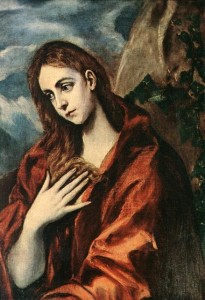 greatest saints…ever!
greatest saints…ever!
One of the best conversations we’ve had about St. Mary Magdalene was with the wonderful Amy Welborn, author of “Decoding Mary Magdalene”
[powerpress]
Artists and musicians have tried to capture Mary Magdalene;  here’s a beautiful tribute to their efforts:
Tags: amy welborn, catholic, catholic podcast, catholic prayer, cathollc spirituality, demons, our sunday visitor, saints, st mary magdalene, witness, women
This entry was posted on Tuesday, July 22nd, 2014 at 5:07 am
You can follow any responses to this entry through the RSS 2.0 feed.
Praying to Saints
[powerpress]
On this faith check let’s answer the question, “why pray to a saint when you can pray straight to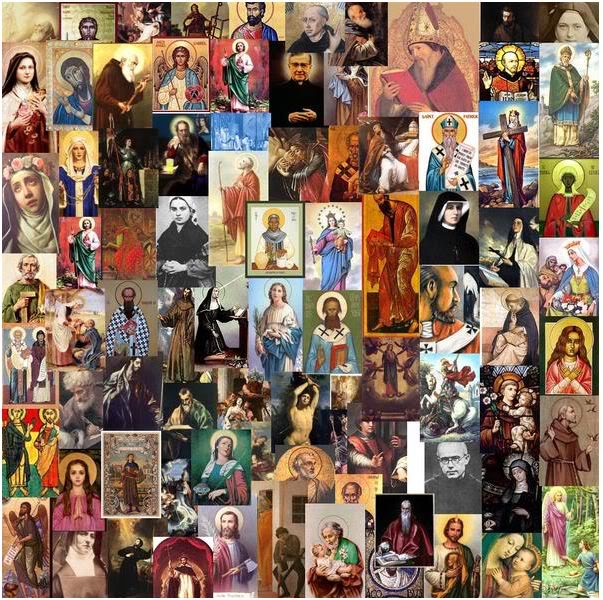 God?â€
God?â€
Of course, Catholics can and do pray straight to God. But we also pray to saints, not to worship them, but simply to ask for their prayers on our behalf, just like we ask our friends on earth to pray for us.
In the communion of saints we are spiritually connected to believers in the here and now and in the hereafter. For instance, Hebrews tells us we are surrounded by a “great cloud of witnesses,â€1 who are aware of what’s going on here. We read in Revelation that the prayers of the elders and saints in heaven are ascending before the throne of God.2
The prayers of the saints are powerful because they have been perfected in God’s grace and as St. James says, “the fervent prayer of the righteous has great power.â€3
Early Christian writings demonstrate that this practice was not a later corruption, but goes back to the very first centuries of Christianity. So let us join with Christians of all ages in saying “all you holy men and women, pray for us!â€
1 -Â 12:1
2 -Â 5:8; 8:3; etc.
3 -Â 5:16
Tags: cloud of witnesses, communion of saints, faith, prayers, prayers of the saints, praying to saints, saints, women
This entry was posted on Monday, July 29th, 2013 at 12:09 am
You can follow any responses to this entry through the RSS 2.0 feed.
[powerpress]
O God,
who by the Immaculate Conception
of the Blessed Virgin Mary,
did prepare a worthy dwelling place for Your Son,
we beseech You that,
as by the foreseen death of this, Your Son,
You did preserve Her from all stain,
so too You would permit us,
purified through Her intercession,
to come unto You.
Through the same Lord Jesus Christ,
Your Son, who lives and reigns with You
in the unity of the Holy Spirit,
God, world without end.
Amen.
O Mary, Mother of God,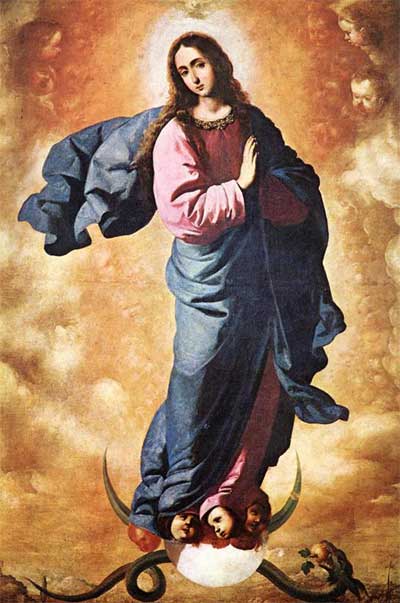
endowed in your glorious Immaculate Conception
with the fullness of grace;
unique among women
in that you are both mother and virgin;
Mother of Christ and Virgin of Christ,
we ask you to look down with a tender heart
from your throne and listen to our prayers
as we earnestly ask that you obtain for us
the favor for which we now plead…
(State your intention here…)
O Mary of the Immaculate Conception,
Mother of Christ,
you had influence with your Divine Son while upon this earth;
you have the same influence now in heaven.
Pray for us
and obtain for us from him
the granting of my petition if it be the Divine Will.
Amen.
For the complete 9 day novena visit the Discerning Hearts:
The Immaculate Conception Novena page
Tags: immaculate conception, mother, prayers, women
This entry was posted on Sunday, December 2nd, 2012 at 12:18 am
You can follow any responses to this entry through the RSS 2.0 feed.
I love this book…what a wonderful introduction on how the Communion of Saints can change our lives.  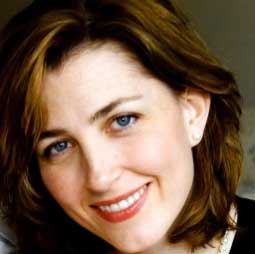 Colleen Carroll Campbell writes a beautiful memoir that not only chronicles the  important passages of life she’s traveled thus far, but she also shares the guidance and insight she has received from several “sister” saints she has met along the way…St. Teresa of Avila, St. Therese of Lisieux, St. Faustina, St. Teresa Benedicta of the Cross (Edith Stein), Bl. Teresa of Calcutta and, of course, the Queen and Mother of them all, The Blessed Virgin Mary.  This work is more than just a cataloging of the events of her life or facts about these incredible women, Colleen shares a compelling story that is truly a page turner.  It was a book that brought  great joy and peace to my heart; it helped me  to reflect on, and appreciate more fully, those wonderful members of the “Cloud of Witnesses” who have touched my life….what a true gift God has given us in the Communion of the Saints.  A  HIGHLY recommended book on all levels.
Colleen Carroll Campbell writes a beautiful memoir that not only chronicles the  important passages of life she’s traveled thus far, but she also shares the guidance and insight she has received from several “sister” saints she has met along the way…St. Teresa of Avila, St. Therese of Lisieux, St. Faustina, St. Teresa Benedicta of the Cross (Edith Stein), Bl. Teresa of Calcutta and, of course, the Queen and Mother of them all, The Blessed Virgin Mary.  This work is more than just a cataloging of the events of her life or facts about these incredible women, Colleen shares a compelling story that is truly a page turner.  It was a book that brought  great joy and peace to my heart; it helped me  to reflect on, and appreciate more fully, those wonderful members of the “Cloud of Witnesses” who have touched my life….what a true gift God has given us in the Communion of the Saints.  A  HIGHLY recommended book on all levels.
[powerpress]
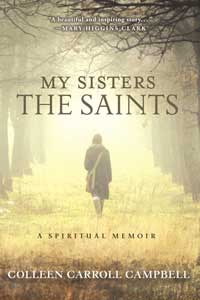 You can find the book here
You can find the book here
“Colleen Carroll Campbell has encountered most of the challenges confronting young women today—balancing dating, courtship, and marriage with a successful career, caring for a parent with Alzheimer’s, dealing with infertility—but she hasn’t faced these challenges alone. In My Sisters the Saints, Campbell introduces us to the women who helped her along the way – women like Teresa of Avila, Therese of Lisieux, Edith Stein, and, of course, the Blessed Virgin Mary. Completely contemporary and totally timeless, My Sisters the Saints is an engaging spiritual memoir and the perfect guidebook for anyone who is looking for a companion to help her navigate life’s sometimes difficult and confusing journey.†– Cardinal Timothy Dolan, Archbishop of New York
“In this fascinating memoir, Colleen Carroll Campbell recounts her discovery of kinship with six great women saints at crucial junctures on her journey through life. My Sisters the Saints is the story of how a thoroughly modern woman drew inspiration and strength from her spiritual ‘sisters’ while struggling with the mysteries of life, love, illness, and death in today’s world. This lovely and highly readable book will touch many lives.â€â€¨- Mary Ann Glendon, former U.S. Ambassador to the Vatican, Harvard Law professor, and President of the Pontifical Academy of Social Sciences
Tags: Cardinal Timothy Dolan, Colleen Carroll Campbell, image books, Mary Ann Glendon, women
This entry was posted on Monday, November 5th, 2012 at 1:58 pm
You can follow any responses to this entry through the RSS 2.0 feed.
What great fun and an outstanding resource all in one fantastic book. Â I love Jane Austen…I love this book. Â  Elizabeth Kantor gets it so right! Â The book description says it best:
Elizabeth Kantor gets it so right! Â The book description says it best:
Women today are settling for less than we want when it comes to men, relationships, sex, and marriage. But we don’t have to, argues Elizabeth Kantor. Jane Austen can show us how to find the love we really want.
In The Jane Austen Guide to Happily Ever After, Kantor reveals how the examples of Jane Austen heroines such as Elizabeth Bennett, Elinor Dashwood, and Anne Elliot can help us navigate the modern-day minefields of dating, love, relationships, and sex. By following in their footsteps—and steering clear of the sad endings suffered by characters such as Maria Bertram and Charlotte Lucas—modern women can discover the path to lifelong love and true happiness.
Charged with honesty and humor, Kantor’s book includes testimonies from modern women, pop culture parallels, the author’s personal experiences and, of course, a thorough examination of Austen’s beloved novels.
[powerpress]
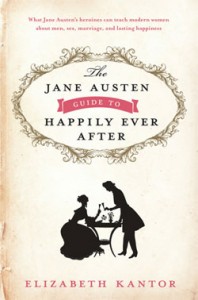 You can find the book here
You can find the book here
“This book would have helped me avoid a few broken hearts for sure! Kantor teaches you how to guard your emotions in an independent, sophisticated, and empowered way through Jane Austen’s works. She offers timeless wisdom for the modern woman, and most importantly, encourages us to take our relationships seriously.”
—Amy Bonaccorso, author of How to Get to “I Do”
Tags: catholic, catholic podcast, catholic prayer, cathollc spirituality, Elizabeth Kantor, hearts, jane austen, love, regenery, women
This entry was posted on Friday, June 1st, 2012 at 7:46 am
You can follow any responses to this entry through the RSS 2.0 feed.
The Angel of the Lord declared to Mary: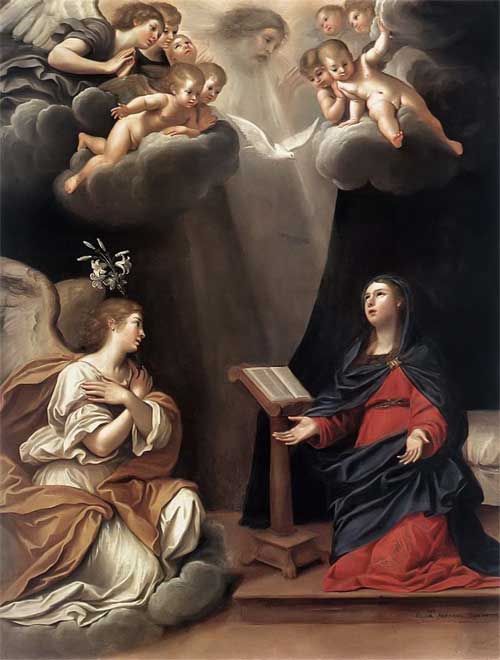
Hail Mary, full of grace, the Lord is with thee; blessed art thou among women and blessed is the fruit of thy womb, Jesus. Holy Mary, Mother of God, pray for us sinners, now and at the hour of
our death. Amen.
Behold the handmaid of the Lord: Be it done unto me according to Thy word.
And the Word was made Flesh: And dwelt among us. Hail Mary . . .
Hail Mary . . .
Pray for us, O Holy Mother of God, that we may be made worthy of the promises of Christ.
Let us pray:
Pour forth, we beseech Thee, O Lord, Thy grace into our hearts; that we, to whom the incarnation of Christ, Thy Son, was made known by the message of an angel, may by His Passion and Cross be brought to the glory of His Resurrection, through the same Christ Our Lord.
Amen.
“Hail, full of grace, the Lord is with you” (Lk 1:28)
“Blessed are you among women,
and blessed is the fruit of your womb”
(Lk 1:42).
Tags: catholic, catholic podcast, catholic prayer, cathollc spirituality, full of grace, hail mary, Holy Mary, mother of god, sacred music, the angelus, Thy Son, women
This entry was posted on Sunday, March 25th, 2012 at 3:52 am
You can follow any responses to this entry through the RSS 2.0 feed.
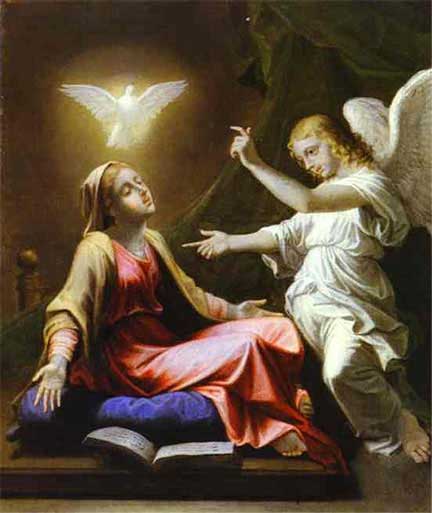 The lyrics and translation are as follows:
The lyrics and translation are as follows:
Hail Mary, full of grace, the Lord is with thee.
Blessed art thou amongst women, and blessed is the fruit of thy womb, Jesus.
Holy Mary, Mother of God, pray for us sinners, now and at the hour of our death.
Amen
Ãve MarÃa, grátia pléna, Dóminus técum.
BenedÃcta tu in muliéribus, et benedÃctus frúctus véntris túi, Iésus.
Sáncta MarÃa, Máter Déi, óra pro nóbis peccatóribus, nunc et in hóra mórtis nóstrae.
Ãmen.
Tags: catholic, Catholic Hymns of Praise, catholic podcast, catholic prayer, cathollc spirituality, death, hail mary, Holy Mary, women
This entry was posted on Sunday, October 23rd, 2011 at 12:06 am
You can follow any responses to this entry through the RSS 2.0 feed.
Episode 7 – Great Works in Western Literature with Joseph Pearce – Harriet Beecher Stowe
Harriet Beecher Stowe was appalled by slavery, and she took one of the few options open to nineteenth century women who wanted to affect public opinion: she wrote a novel, a huge, enthralling narrative that claimed the heart, soul, and politics of 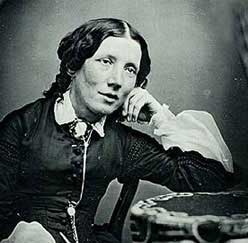 millions of her contemporaries. Uncle Tom’s Cabin paints pictures of three plantations, each worse than the other, where even the best plantation leaves a slave at the mercy of fate or debt. Her questions remain penetrating even today: “Can man ever be trusted with wholly irresponsible power?”
millions of her contemporaries. Uncle Tom’s Cabin paints pictures of three plantations, each worse than the other, where even the best plantation leaves a slave at the mercy of fate or debt. Her questions remain penetrating even today: “Can man ever be trusted with wholly irresponsible power?”
First published more than 150 years ago, this monumental work is today being reexamined by critics, scholars, and students. Though “Uncle Tom” has become a synonym for a fawning black yes-man, Stowe’s Tom is actually American literature’s first black hero, a man who suffers for refusing to obey his oppressors. Uncle Tom’s Cabin is a living, relevant story, passionate in its vivid depiction of the cruelest forms of injustice and inhumanity-and the courage it takes to fight against them.
[powerpress]
 Based on the Ignatius Critical Edition, this series examines, from the Judeo-Christian perspective, the life, the times, and influence of authors of great works in literature .
Based on the Ignatius Critical Edition, this series examines, from the Judeo-Christian perspective, the life, the times, and influence of authors of great works in literature .
Joseph Pearce is currently the Writer-in-Residence and Visiting Fellow at Thomas More College of Liberal Arts in Merrimack, New Hampshire. He is also Visiting Scholar at Mount Royal Academy in Sunapee, New Hampshire. He is also Visiting Scholar at Mount Royal Academy in Sunapee, New Hampshire. He is co-editor of the Saint Austin Review (or StAR), an international review of Christian culture, literature, and ideas published in England (Family Publications) and the United States (Sapientia Press). He is also the author of many books, including literary biographies of Solzhenitsyn, J. R. R. Tolkien, C. S. Lewis, G. K. Chesterton, and Oscar Wilde.
To learn more about the authors and titles available in the Ignatius Critical Editions
Tags: ave maria university, catholic, catholic podcast, catholic prayer, cathollc spirituality, harriet beecher stowe, Harriet Beecher Stowe Harriet Beecher Stowe, heart, ignatius critical editions, joseph pearce, literary biographies, mercy, sapientia press, women
This entry was posted on Friday, October 14th, 2011 at 1:23 pm
You can follow any responses to this entry through the RSS 2.0 feed.
Six Insights from the Life of Dorothy Day from Province of Saint Joseph on Vimeo.
6 Insights from the Life of Dorothy Day –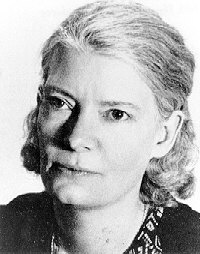
(from Our Sunday Visitor)
“Dorothy Day is one of the most significant women in the life of the Church in the United States.” That’s how Archbishop Timothy Dolan of New York began a moving and inspiring talk about the founder of the Catholic Worker Movement on the anniversary of her birthday Nov. 9 at St. Joseph’s Church in Greenwich Village. The video clip above is worth watching to the end. I had tears in my eyes by the time it was over, but I’ll give you the synopsis of what Archbishop Dolan labeled the six “insights” we can take from Dorothy Day.
1. “She was quintessentially American.” The archbishop went on to emphasize that Dorothy’s faith was freely chosen. She was raised Protestant and converted to Catholicism. Her faith was “her free choice,” something Archbishop Dolan said should resonate particularly well with Americans who more and more reject the faith of their births.
2. “Dorothy was from the beginning a social critic and activist in the best prophetic sense of American Christian spirituality, whether Protestant, Catholic, or Orthodox.” The archbishop said that Dorothys’ vision and her intellectual c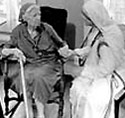 ontributions may well have “foreshadowed” what Pope John XXIII, Vatican II, and Pope John Paul II tried to advance “relative to the dignity of each person as a worker, as a human being created in the image and likeness of God.”
ontributions may well have “foreshadowed” what Pope John XXIII, Vatican II, and Pope John Paul II tried to advance “relative to the dignity of each person as a worker, as a human being created in the image and likeness of God.”
3. “Dorothy’s mission to the Church in every area — social and legal reform, workers’ rights, publications, her renowned pacifism, the ability to prophetically challenge even Church authority — all of that found its taproot in prayer,” something the archbishop said is too often reversed by reform-minded leaders. He stressed that Dorothy began and ended each day with prayer and rarely missed daily Mass, adding, “Her activism was the fruit of a profound prayer that I would say bordered on the mystic.”

4. “Dorothy lived through two experiences of her day that are particularly enlightening for us today. Experience one: loneliness, alienation and disconnection to foundational institutions such as marriage and family. Secondly, the sexual revolution…” Archbishop Dolan called her life one of “upheaval,” but said that her Augustinian model of faith reminds us that our sexuality cannot be cast aside as a weakness but is integral to our lives as an expression of our likeness to God. “She invites us to watch her grow in integrity in this most precious act of being human,” he said.
5. “Dorothy neither hid from sin nor would allow any person, no matter their motives, to be simply equated with the sum of their sins. We are not ever or only the sum total of our sins, are we?” The archbishop said that Dorothy’s life was “ever in process” and she was ever more converted to Jesus Christ every day. “Holiness of life, Dorothy would tell us, would have no chance without honesty at its base,” he said, stressing that we cannot deny or lawyer up when it comes to our mistakes.
6. “Dorothy was a woman of the Church. She loved being a Catholic. She loved the Catholic Church. I’m not talking about some nebulous, generic Church. She loved the one, holy, catholic, apostolic, Roman church…She was proud to be Catholic.”
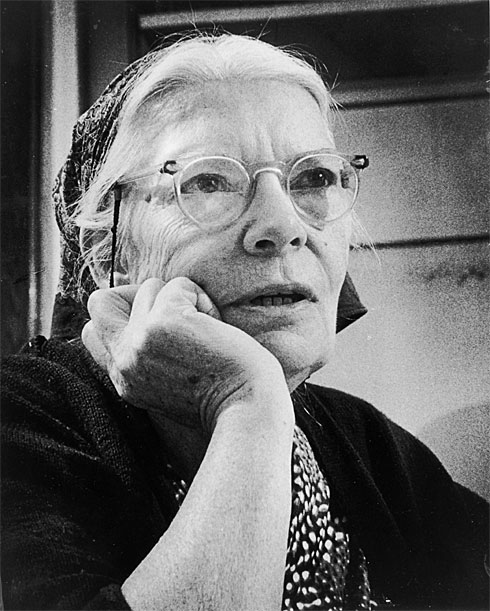 Finally, Archbishop Dolan went on to say that our greatest pastoral challenge as Catholics today is to “respond to those who want Christ without his Church, and their name is legion.” Saying that many people don’t have a problem with Jesus but have “tons of problems” with his Church, he pointed out that Dorothy knew full well the flaws of her Church and loved it anyway:
Finally, Archbishop Dolan went on to say that our greatest pastoral challenge as Catholics today is to “respond to those who want Christ without his Church, and their name is legion.” Saying that many people don’t have a problem with Jesus but have “tons of problems” with his Church, he pointed out that Dorothy knew full well the flaws of her Church and loved it anyway:
“She loved the mystical body, but she new the mystical body had warts galore…Here’s one of her saltier quotes, and there were many: ‘Yes, the Church is the spotless bride of Christ, but at other times, she’s the whore of Babylon.’ Dorothy was well aware of the flaws, the wounds, the imperfections, the ugly side of the Church, but she loved it all the more.” Our Sunday Visitor
Tags: archbishop dolan, catholic, catholic church, catholic podcast, catholic prayer, cathollc spirituality, Church, dorothy day, prayer, women
This entry was posted on Saturday, November 13th, 2010 at 8:55 am
You can follow any responses to this entry through the RSS 2.0 feed.
Dr. Patricia Cooney Hathaway concentrates on helping women understand the relationship between 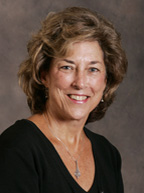 faith and human experience during the middle years within the context of the whole life cycle. This book is EXCELLENT! She explores the wrenching and puzzling questions women in their middle years need to ask: Who am I? Who am I with? Where am I going in terms of a life plan? What aids or blocks my growth? Is God a personal God who is invested in my life? Do I have a personal destiny related to God? What is the meaning of suffering? What is my fate after death?  Drawing from the Mystical Doctors of the Church, Dr. Hathaway offeres an ou
faith and human experience during the middle years within the context of the whole life cycle. This book is EXCELLENT! She explores the wrenching and puzzling questions women in their middle years need to ask: Who am I? Who am I with? Where am I going in terms of a life plan? What aids or blocks my growth? Is God a personal God who is invested in my life? Do I have a personal destiny related to God? What is the meaning of suffering? What is my fate after death?  Drawing from the Mystical Doctors of the Church, Dr. Hathaway offeres an ou tstanding spiritual resource for women.
tstanding spiritual resource for women.
[powerpress]
Click here to pick up a copy of Patricia’s book
Tags: catholic, catholic podcast, catholic prayer, cathollc spirituality, Cooney Hathaway, human experience, Patricia Cooney Hathaway, women
This entry was posted on Tuesday, September 14th, 2010 at 8:56 pm
You can follow any responses to this entry through the RSS 2.0 feed.
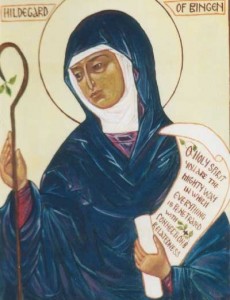 Once again the Holy Father, Pope Benedict XVI speaks of the importance of St. Hildegard of Bingen.
Once again the Holy Father, Pope Benedict XVI speaks of the importance of St. Hildegard of Bingen.
Vatican City – Pope Benedict’s General Audience from Vatican.va
Dear Brothers and Sisters, Today I would like to take up and continue my Reflection on St Hildegard of Bingen, an important female figure of the Middle Ages who was distinguished for her spiritual wisdom and the holiness of her life. Hildegard’s mystical visions resemble those of the Old Testament prophets: expressing herself in the cultural and religious categories of her time, she interpreted the Sacred Scriptures in the light of God, applying them to the various circumstances of life. Thus all those who heard her felt the need to live a consistent and committed Christian lifestyle. In a letter to St Bernard the mystic from the Rhineland confesses: “The vision fascinates my whole being: I do not see with the eyes of the body but it appears to me in the spirit of the mysteries…. I recognize the deep meaning of what is expounded on in the Psalter, in the Gospels and in other books, which have been shown to me in the vision. This vision burns like a flame in my breast and in my soul and teaches me to understand the text profoundly” (Epistolarium pars prima I-XC: CCCM 91). Hildegard’s mystical visions have a rich theological content. They refer to the principal events of salvation history, and use a language for the most part poetic and symbolic. For example, in her best known work entitled Scivias, that is, “You know the ways” she sums up in 35 visions the events of the history of salvation from the creation of the world to the end of time. With the characteristic traits of feminine sensitivity, Hildegard develops at the very heart of her work the theme of the mysterious marriage between God and humanity that is brought about in the Incarnation. On the tree of the Cross take place the nuptials of the Son of God with the Church, his Bride, filled with grace and the ability to give new children to God, in the love of the Holy Spirit (cf. Visio tertia: PL 197, 453c).
From these brief references we already see that theology too can receive a special contribution from women because they are able to talk about God and the mysteries of faith using their own particular intelligence and sensitivity. I therefore encourage all those who carry out this service to do it with a profound ecclesial spirit, nourishing their own reflection with prayer and looking to the great riches, not yet fully explored, of the medieval mystic tradition, especially that represented by luminous models such as Hildegard of Bingen.
The Rhenish mystic is also the author of other writings, two of which are particularly important since, like Scivias, they record her mystical visions: they are the Liber vitae meritorum (Book of the merits of life) and the Liber divinorum operum (Book of the divine works), also called De operatione Dei. In the former she describes a unique and powerful vision of God who gives life to the cosmos with his power and his light. Hildegard stresses the deep relationship that exists between man and God and reminds us that the whole creation, of which man is the summit, receives life from the Trinity. The work is centred on the relationship between virtue and vice, which is why human beings must face the daily challenge of vice that distances them on their way towards God and of virtue that benefits them. The invitation is to distance themselves from evil in order to glorify God and, after a virtuous existence, enter the life that consists “wholly of joy”. In her second work that many consider her masterpiece she once again describes creation in its relationship with God and the centrality of the human being, expressing a strong Christo-centrism with a biblical-Patristic flavour. The Saint, who presents five visions inspired by the Prologue of the Gospel according to St John, cites the words of the Son to the Father: “The whole task that you wanted and entrusted to me I have carried out successfully, and so here I am in you and you in me and we are one” (Pars III, Visio X: PL 197, 1025a). Finally, in other writings Hildegard manifests the versatility of interests and cultural vivacity of the female monasteries of the Middle Ages, in a manner contrary to the prejudices which still weighed on that period. Hildegard took an interest in medicine and in the natural sciences as well as in music, since she was endowed with artistic talent. Thus she composed hymns, antiphons and songs, gathered under the title: Symphonia Harmoniae Caelestium Revelationum (Symphony of the Harmony of Heavenly Revelations), that were performed joyously in her monasteries, spreading an atmosphere of tranquillity and that have also come down to us. For her, the entire creation is a symphony of the Holy Spirit who is in himself joy and jubilation.
The popularity that surrounded Hildegard impelled many people to seek her advice. It is for this reason that we have so many of her letters at our disposal. Many male and female monastic communities turned to her, as well as Bishops and Abbots. And many of her answers still apply for us. For instance, Hildegard wrote these words to a community of women religious: “The spiritual life must be tended with great dedication. At first the effort is burdensome because it demands the renunciation of caprices of the pleasures of the flesh and of other such things. But if she lets herself be enthralled by holiness a holy soul will find even contempt for the world sweet and lovable. All that is needed is to take care that the soul does not shrivel” (E. Gronau, Hildegard. Vita di una donna profetica alle origini dell’età moderna, Milan 1996, p. 402). And when the Emperor Frederic Barbarossa caused a schism in the Church by supporting at least three anti-popes against Alexander iii, the legitimate Pope, Hildegard did not hesitate, inspired by her visions, to remind him that even he, the Emperor, was subject to God’s judgement. With fearlessness, a feature of every prophet, she wrote to the Emperor these words as spoken by God: “You will be sorry for this wicked conduct of the godless who despise me! Listen, O King, if you wish to live! Otherwise my sword will pierce you!” (ibid., p. 412). With the spiritual authority with which she was endowed, in the last years of her life Hildegard set out on journeys, despite her advanced age and the uncomfortable conditions of travel, in order to speak to the people of God. They all listened willingly, even when she spoke severely: they considered her a messenger sent by God. She called above all the monastic communities and the clergy to a life in conformity with their vocation. In a special way Hildegard countered the movement of German cátari (Cathars). They cátari means literally “pure” advocated a radical reform of the Church, especially to combat the abuses of the clergy.
She harshly reprimanded them for seeking to subvert the very nature of the Church, reminding them that a true renewal of the ecclesial community is obtained with a sincere spirit of repentance and a demanding process of conversion, rather than with a change of structures. This is a message that we should never forget. Let us always invoke the Holy Spirit, so that he may inspire in the Church holy and courageous women, like St Hildegard of Bingen, who, developing the gifts they have received from God, make their own special and valuable contribution to the spiritual development of our communities and of the Church in our time.
Tags: catholic, catholic podcast, catholic prayer, cathollc spirituality, Church, courageous women, Hildegard of Bingen, holy spirit, mysteries, mystic of the Church, mystics, pope benedict, pope benedict xvi, st hildegard of bingen, women, women of the middle ages
This entry was posted on Wednesday, September 8th, 2010 at 4:08 pm
You can follow any responses to this entry through the RSS 2.0 feed.
